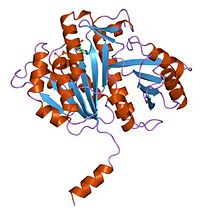
Photo from wikipedia
Mutations of human oncoprotein p21H-Ras (hereafter "Ras") at glutamine 61 are known to slow the rate of guanosine triphosphate (GTP) hydrolysis and transform healthy cells into malignant cells. It has… Click to show full abstract
Mutations of human oncoprotein p21H-Ras (hereafter "Ras") at glutamine 61 are known to slow the rate of guanosine triphosphate (GTP) hydrolysis and transform healthy cells into malignant cells. It has been hypothesized that this glutamine plays a role in the intrinsic mechanism of GTP hydrolysis by interacting with an active site water molecule that stabilizes the formation of the charged transition state at the γ-phosphate during hydrolysis. However, there is no comprehensive data set of the effects of mutations to Q61 on the protein's intrinsic catalytic rate, structure, or interactions with water at the active site. Here, we present the first comprehensive and quantitative set of initial rates of intrinsic hydrolysis for all stable variants of RasQ61X. We further conducted enhanced molecular dynamics (MD) simulations of each construct to determine the solvent accessible surface area (SASA) of the side chain at position 61 and compared these results to previously measured changes in electric fields caused by RasQ61X mutations. For polar and negatively charged residues, we found that the rates are normally distributed about an optimal electrostatic contribution, close to that of the native Q61 residue, and the rates are strongly correlated to the number of waters in the active site. Together, these results support a mechanism of GTP hydrolysis in which Q61 stabilizes a transient hydronium ion, which then stabilizes the transition state while the γ-phosphate is undergoing nucleophilic attack by a second, catalytically active water molecule. We discuss the implications of such a mechanism on future strategies for combating Ras-based cancers.
Journal Title: Biochemistry
Year Published: 2018
Link to full text (if available)
Share on Social Media: Sign Up to like & get
recommendations!